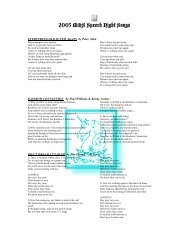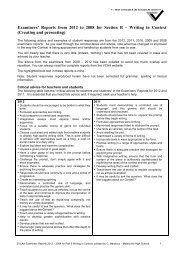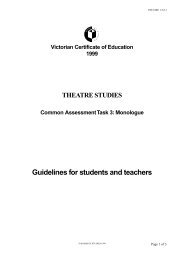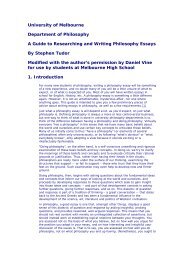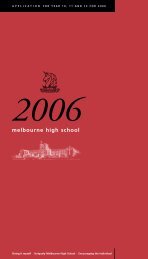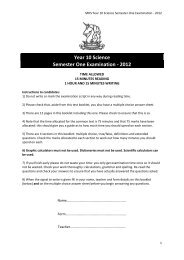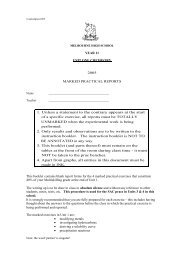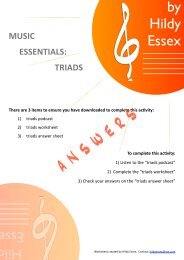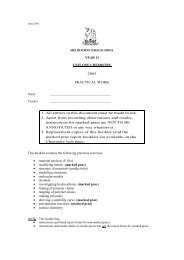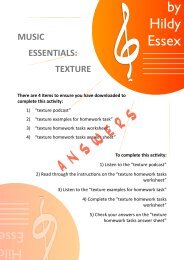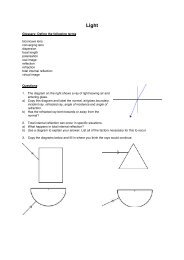Melbourne High School Information
Melbourne High School Information
Melbourne High School Information
Create successful ePaper yourself
Turn your PDF publications into a flip-book with our unique Google optimized e-Paper software.
Preparing for the ITSA EPTs.<strong>Melbourne</strong> <strong>High</strong> <strong>School</strong>It is important to note that practice will not significantly affect your child’s performance on the ITSAtests. However, practising the actual procedure for taking a test can give your child the opportunityto perform to the best of their ability. ITSA has a set of practice tests on its website. Children canlog on with their parent prior to testing day and take the practice set of tests. There will be a fee of$AUD22 (GST inc.) charged for each set of tests. There is also a series of practice questions at theback of this booklet.Before Sitting the EPTs■ Make sure your child gets a good night’s sleep prior to the testing day.■Try to refrain from putting pressure on your child to perform. Stress is one of the key reasonswhy some children perform below their ability on the tests.■ Make sure that your child goes to the toilet before the tests.■Arrive about 30 minutes before the tests are due to commence. Arriving too early or just beforetesting is very anxiety provoking for most students.What Should You Bring to the Test?Your child should only bring the following items to the testing:■ Two pens (blue or black)■ One pencil sharpener (ITSA will provide pencils and erasers)■■We advise students to bring a watch or silent clock, as students are considered responsible formonitoring their own progress during the testsExamination number supplied by <strong>Melbourne</strong> <strong>High</strong> <strong>School</strong> in the <strong>Information</strong> Package sent oneweek prior to the examination date■ Photo ID e.g. current school’s ID card■A small snack and/or drink to be consumed in the break (no food or drink will be delivered tostudents during the examination).No other items will be permitted in the examination roomPencil cases, scribbling paper, calculators, bags, etc. are not permitted.It is PROHIBITED for students to bring mobile telephones into the examination centre.ITSA will supply all other equipment when it is required.10
<strong>Melbourne</strong> <strong>High</strong> <strong>School</strong>Taking the EPTs.■ There are six separate tests to complete in the Entrance Examination.■ In total, they take about three hours, with a short break in the middle.■ Most of the tests are in multiple-choice format.■ Each student will be seated at a numbered desk.■■The desk number becomes each student’s identification number, and this will be sent to eachstudent the week prior to the day of testing via the <strong>Information</strong> Package.On the day each student is issued with a special computer pencil that is used to indicateanswers to the questions of each test answer sheet.ITSA Policy on Cheating1 As ITSA tests are competitive, students must ensure they:■ do not bring any unauthorised materials into the test room■ do not communicate with any other student during testing, and■ obey all reasonable instructions of ITSA staff.2 If the identity of a student is called into doubt, ITSA and/or the school may require re-testing.3 Any student found cheating will be removed from the test room and/or have their resultscancelled.There will be NO REFUND of fees under these circumstances. Cancellation of results for cheatingwill be at the absolute discretion of ITSA staff.Interpretation of the ITSA EPT Results.■ Will be at the absolute discretion of ITSA staff.■ The school will provide parents with a written report following ITSA testing for the EntranceExamination.■ This report is called an ITSA Educational Profile.■ It is a confidential report that tells parents the abilities and educational attainments of theirchildren, as shown on one particular testing.■ They may reveal educational difficulties, average or above-average achievement or outstandingperformances.We take the raw scores obtained on each test and check to see that they are approximatelynormally distributed. (There is considerable evidence to suggest that scores on all of our testsshould be normally distributed and results over 20 years support this belief.) It follows that moststudents in any large group will obtain scores that are close to the average or middle score and justa few students will obtain very high or very low scores.11
<strong>Melbourne</strong> <strong>High</strong> <strong>School</strong>We then convert the scores by dividing the normal distribution into categories.The percentage of peoplein each category across thenation on aptitude andachievement tests:Each of the categories on the scale holds a different proportion of students. A diagram of how thecuts are made is printed with each parent report so that both parents and students can see exactlyhow the scores compare with other students. The conversion is based on the scores obtained bystudents who sat the <strong>Melbourne</strong> <strong>High</strong> <strong>School</strong> and The Mac.Robertson Girls <strong>High</strong> <strong>School</strong> exam.You can see that the first category is ‘Below Average’ category, and 23% of students of a particularyear level may get a score in this range. The last category is ‘Superior’, and 11% of students of aparticular year level may get a score in this range. The middle section corresponds with the‘Average’ category, and 20% of students of a particular year level may get a score in this range. 17%of students fall into the ‘Low Average’ and also the ‘<strong>High</strong> Average’ categories, and 12% fall into the‘Above Average’ category.The use of categories provides an easily understood method for conveying educational informationto both school staff and parents. Categories, because they are not precise measures, remind us thatthere is always a small error in any measurement and that any test result, based on a single test,can only give an estimate of “true” achievement or aptitude levels for a student.The use of categories also permits comparison of results across all of the tests. It is expected thata student who gets an ‘Average’ category on the aptitude tests (Verbal & Numerical Reasoning)should also get ‘Average’ for each of the achievement tests (Reading Comprehension,Mathematics, Creative Expression & Analytical Expression). Where a result is two or morecategories different, it is suggestive of uneven learning and could be revealing a specific weaknessor strength, relative to the overall performance of the student.Results on <strong>School</strong> Reports and ITSA Educational Profiles are sometimes different. This isbecause school reports are often based on criterion-referenced tests and EPT results are basedon your child’s performance in comparison with the other students who sat the entrance exam.12
Frequently Asked Questions.Q. How are boys selected at Year 9?<strong>Melbourne</strong> <strong>High</strong> <strong>School</strong>A. Boys who sit the Entrance Examination are ranked according to their aggregate score. To beconsidered for selection a student must reach an acceptable standard in all sections of theEntrance Examination. Over 1200 boys sat the Entrance Examination in 2003 for entry into Year9, 2004. <strong>Melbourne</strong> <strong>High</strong> <strong>School</strong> has 336 places available at Year 9.Q. What is the 3% rule? How does it work?A. The maximum number of students admitted into <strong>Melbourne</strong> <strong>High</strong> <strong>School</strong> and TheMac.Robertson Girls <strong>High</strong> <strong>School</strong> combined from any one school must not exceed 3% of thatcontributing school’s Year 8 enrolment. For example, if there are 120 students (boys and girls)enrolled at your child’s high school, <strong>Melbourne</strong> <strong>High</strong> <strong>School</strong> and The Mac.Robertson Girls <strong>High</strong><strong>School</strong> combined can only select the highest ranked four students (3%) who score above thecut-off mark. This means some students who score above the cut-off mark may miss out onbeing offered a place, as we cannot exceed the 3% ceiling.The 3% rule is a State Government policy provided by the Department of Education andTraining (Executive Memorandum 99/010).Q. What is the cut-off mark?A. The cut-off mark is detemined by a combination of 319 places available (95% of the total Year9 intake) and the 3% rule. That is, candidates are listed in Entrance Examination raw score(rank) order. We scroll down through the list, taking into account the 3% rule, until 319 placesare filled. The cut-off score is then determined as the raw score of the 319th candidate placedin this process.Q. What is the Principal’s Discretionary Category? How do you place the final 5% (17) candidates?A. Applications to be considered for the Principal’s Discretionary Category are offered after theEntrance Examination to all boys who:■ missed a place because of the 3% rule■ were within five marks of the cut-off score.This process involves selecting 17 boys through application, shortlisting and interviewing. In2003, for entry into 2004, over 160 candidates were eligible to be considered under thePrincipal’s Discretionary Category.Q. What are the <strong>School</strong> fees?A. <strong>School</strong> fees vary according to the student’s subjects.■ Year 9 & 10 approximate fees – $2000 per annum■ Year 11 & 12 approximate fees – $1500 per annum.These fees do not include books or school uniform. The <strong>School</strong> has a second-hand uniformshop which parents are encouraged to use. Second-hand books are available through ourbookseller.13
Q. Are there places for boys to enter in Years 10–12?<strong>Melbourne</strong> <strong>High</strong> <strong>School</strong>A. It varies from year to year, but generally we have limited vacancies in Years 10–12. Selectionfor entry into Years 10–12 is not by Entrance Examination. Boys are selected via a writtenapplication process. They submit a copy of their current mid year report and supportingdocumentation demonstrating any sporting, musical, leadership or other special abilities. Fromthis a shortlist of applicants for interview is decided by the relevant panel. Applications for theseyear levels must be received by the end of August.Q. Are there scholarships or right of entry for sons of Old Boys?A. <strong>Melbourne</strong> <strong>High</strong> <strong>School</strong> does not offer any entry scholarships. Boys are selected at Year 9 byEntrance Examination and at Years 10–12 by application and subsequent shortlisting andinterview. There is no right of entry for any student nor any feeder schools or zones.Q. How do the students travel to school?A. <strong>Melbourne</strong> <strong>High</strong> <strong>School</strong> has a very large student catchment area. Most of the boys travel toschool by train to South Yarra station, tram or bus. Public transport travel is used by moststudents and forms an integral part of the network of students at <strong>Melbourne</strong> <strong>High</strong> <strong>School</strong>.Q. What is the size of the <strong>School</strong>?A. There are over 1360 students enrolled at the <strong>School</strong>. The staff consists of the Principal, 3Assistant Principals, and over 90 teaching staff.Q. Is there Saturday morning sport?A. Sport is compulsory for all students. Sport is conducted one afternoon per week during schoolhours. Many boys are involved in <strong>Melbourne</strong> <strong>High</strong> <strong>School</strong> weekend sport, but this is purelyvoluntary. <strong>Melbourne</strong> <strong>High</strong> <strong>School</strong> also competes in the VSSSA (Victorian State Secondary<strong>School</strong>’s Association) competitions.Q. What are the co-curricular expectations?A. All Year 9 boys are expected to be involved in the co-curricular program. These activities includeArmy Cadets, Air Force Cadets, Music Ensembles, Opera, plays, debating, rowing, stage crew,bushwalking, sports medicine, environmental action, student newspaper/magazine and manymore.Q. Can I get a Registration Form from ITSA?A. No. You must visit the school’s website and apply online.Q. What happens if I am late submitting my child’s Registration Form?A. Your child will not be able to sit the tests.Q. What happens if my child doesn’t receive a place?A. The results of the Entrance Examination are not subject to appeal however, you will still receivea confidential, comprehensive Educational Profile, reporting your child’s results on each test.This information is very valuable in identifying strengths and weaknesses and for providinginsights and expectations of your child’s future progress at school.14
<strong>Melbourne</strong> <strong>High</strong> <strong>School</strong>Q. What are the verbal and numerical reasoning tests and how can I help my child prepare forthem?A. The verbal and numerical reasoning tests are designed to show how quickly a student canreason their way through a problem. It measures general mental abilities, by providing anopportunity for students to demonstrate the ability to see relationships and solve problems. It isimportant to note that practice does not significantly affect performance on the ITSA tests but itcan help a student perform to the best of their ability. The practice questions in this booklet cangive your child an idea of the types of questions that will be encountered. The ITSA website canalso provide students with further practice for a fee of $AUD22 (GST inc.) This will give yourchild an idea of the types of questions that will be on the tests.Q. My child performed poorly on the Maths test. Is it possible to obtain a copy of the test so wecan see where my child’s weaknesses are?A. No. In order to keep ITSA tests secure, we do not allow individuals or schools to have accessto them.Q. My child said there were some questions on the Maths test that hadn’t been taught yet.Is my child being disadvantaged?A. The ITSA tests are carefully designed to cover the curriculum appropriate for the year level ofeach student. A student who has a good grasp of most areas covered in the curriculum wouldbe expected to do well on the ITSA tests. There are some additional difficult questions that gobeyond the curriculum, that are included to identify and challenge the high achievers in aparticular area.Q. How soon after my child sits the ITSA tests will we receive results and notification of whethermy child will receive a place?A. You should receive the parent report and notification regarding placement during August.Q. How are my child’s results reported and how can I tell if my child is making good progress atschool?A. Refer to the section relating to Interpretation of Results.Q. My child got a ‘Superior’ rating on the Reading Comprehension test but only an ‘Average’ ratingon the Maths test. Could this be a mistake, or does it mean my child isn’t any good at Maths?A. It is unlikely that this is a mistake, as the results are thoroughly checked before being reportedto schools and parents. Remember an ‘Average’ rating doesn’t suggest that your child isn’tgood at Maths; it suggests your child’s score is equivalent to the average score for thatparticular year level. However, because your child received a superior rating for ReadingComprehension, it does indicate uneven learning and possibly reveals a specific strength orweakness, relative to the overall performance of your child. You might like to check with yourchild whether they had any problems during the Maths test (toilet break; didn’t finish thetests, etc).15
<strong>Melbourne</strong> <strong>High</strong> <strong>School</strong>Q. Can I download the ITSA Web site or print off the online practice tests at work for my child?A. No, this is not possible as the ITSA online practice tests are presented as an interactivecomputer program. Your child must be present and online to be able to complete the onlinepractice tests. If you don’t have a computer at home, you could ring your local library andreserve a computer with internet access (keeping in mind that the practice tests will takeapproximately one hour). A credit card is also required, as a fee of $AUD22 (GST inc.) ischarged for using the practice tests.Q. What computer system/configuration do I need to be able to do the online tests?A. The site can be accessed using a PC or Apple Macintosh, providing they have internet access.The speed at which the site operates will depend on your computer’s processor speed and thespeed of your modem. Internet Explorer Version 6 or Netscape Version 7 are recommended.Q. Will my child be disadvantaged because we don’t have access to the internet?A. No. The internet site allows your child the opportunity to practise the types of questions that areon the actual tests and obtain results. The internet site also provides an opportunity for yourchild to explore computer technology and practise the sample questions in an interesting andinnovative way. Students can also gain practice from the sample questions provided in thisbooklet. You may wish to use these questions as a guide to make up questions of your own.16
<strong>Melbourne</strong> <strong>High</strong> <strong>School</strong>Tips for taking the EPTs.Tip 1.Start at the beginning and work steadily through each test, one question at a time. The EPTs are alldesigned the same way; they start off with several easy questions and then there is a mixture of easyquestions, difficult questions and medium difficulty questions. Don’t spend too much time on any onequestion. It is better to make a guess, move on to others and go back later if you have the time.Tip 2.Read each choice before choosing your answer. On the Verbal Reasoning and ReadingComprehension tests the options can be subtle. You are always looking for the best choice. TheNumerical Reasoning and Maths tests, on the other hand, usually have a clear, correct answer for eachquestion.Tip 3.If you are unsure about an answer, always guess! There is no penalty for guessing and guessingcan increase your overall score. It is usually possible to eliminate some of the choices offered in aparticular question, even if you don’t know the actual answer.Tip 4.Answer questions based only on the information provided – never on what you think you alreadyknow. Particularly on the Reading Comprehension questions, base your answers only on thematerial in the passage, not on any previous knowledge you may have on the subject.Tip 5.You are not allowed to write on the test booklets, but you can do working out on the separate answersheets. It is usually helpful to jot down something when you are doing a question. Use the spaceprovided on the answer sheet for this. If you run out of space, turn the sheet over and work on the back.Tip 6.Be careful marking your answer sheet. Only use the special computer pencil that is provided. Withthe exception of the Creative and Analytical Expression tests, ITSA scores all tests using a computerscanner. It is important to erase errors completely as the scanner cannot distinguish between anaccidental mark, a partially erased answer and a filled-in answer. If the computer registers twoanswers where there should be only one, it will score the question as being wrong. It can only read2B pencil marks, so only use the pencil provided by the test supervisor. If it breaks, get it replacedor sharpen it yourself. You are expected to bring a pencil sharpener with you. Be careful not to makeany stray pencil marks in the answer section of the Answer Sheet.Tip 7.Ensure that you put your answers in the correct position. If you leave answers out, it is easy to getyour answers out of order. Don’t leave answers out. Always make the best guess possible andcheck you are putting the answer next to the correct question number on the Answer Sheet.Tip 8.Fill your answers in neatly, fully and heavily. To ensure that the computer gives you credit for allyour correct answers, fill in your choice fully, neatly and heavily.17
<strong>Melbourne</strong> <strong>High</strong> <strong>School</strong>Practice Questions.Here are some practice questions to help you prepare for the ITSA EPTs.Verbal ReasoningQuestion 1.The word most nearly the OPPOSITE to PERMIT is:A allow B forbid C grant D blame E none of theseQuestion 2.REALISTIC means…A idealistic B romantic C practical D unreal E none of theseQuestion 3.Find the two statements that together prove that Samantha is a good runner.1 Samantha runs around the oval every day2 Samantha has new running shoes3 Katie won this year’s running championship4 Katie and Samantha are friends5 Samantha beat Katie in a race last weekA 1 & 2 B 3 & 4 C 3 & 5 D 1 & 5 E none of theseQuestion 4.The word that means most nearly the SAME as OBESE isA acute B slim C old D fat E averageQuestion 5.Which is NOT a meaning of the word ELATION?A happiness B enthusiasm C exhilaration D emotion E optimismQuestion 6.The word that means most nearly the OPPOSITE to HALT is:A stay B stop C progress D presume E averageQuestion 7.Synonyms are words with similar meanings.Which word is a synonym of TOGETHER?A triplicate B couple C joined D apart E none of these18
<strong>Melbourne</strong> <strong>High</strong> <strong>School</strong>Question 8.Which pair of words BEST expresses the relationship between MILK – CUPA drink – thirsty B liquid – container C cup – saucerD cup – coffeeE drink – eatQuestion 9.Find the two statements that together prove Nick is a good snowboarder.1 Nick is sponsored by Shred Snowboard Company.2 Nick works for Shred Snowboard Company.3 All good snowboarders are sponsored by Shred Snowboard Company.4 Nick has a very expensive snowboard made by Shred Snowboard Company.5 Shred Snowboard Company only sponsors good snowboarders.A 1&3 B 1&5 C 2&3 D 2&4 E 2&5Question 10.Which pair of words BEST expresses the relationship between: GOLF – CLUBA football – field B netball – team C tennis – racquetD soccer – goalE hockey - bootsNumerical ReasoningQuestion 1.What is the missing number in this series?128 117 ? 98 90A 100 B 107 C 108 D 110 E none of theseQuestion 2.Sarah waits for the 8.30am tram but it is five minutes late. The tram then takes eighteen minutes toget to her stop, and then she takes three minutes to run to work. Sarah was meant to start work at9.00am. How late is Sarah for work?A Three minutes B Five minutes C Ten minutesD Fifteen minutesE Sarah is not lateQuestion 3.Find the number that comes next in the series3 6 9 18 ? 42A 20 B 21 C 23 D 36 E none of these19
<strong>Melbourne</strong> <strong>High</strong> <strong>School</strong>Question 4.Find the missing number in this series:3 7 11 ? 19 23A 12 B 14 C 16 D 18 E none of theseQuestion 5.The numbers in the grid have been arranged in patterns. Some of the circles have been shaded tohide their numbers. Use the patterns to find the value of x.x = ?A 12 B 13 C 15 D 16 E none of theseQuestion 6.If six donuts cost as much as one lamington but half the price of a cake, then two cakes will costthe same as:A 12 donuts plus 2 lamingtons B 12 donuts C 2 lamingtonsD 6 donuts plus 2 lamingtons E 6 donutsQuestion 7.The sum of two numbers is 30, and the second divided by the first equals 2. What are the twonumbers?A 5 & 6 B 6 & 24 C 10 & 20 D 30 & 15 E none of theseQuestion 8.Four consecutive numbers add up to 38. What is the largest of the four numbers?A 8 B 6 C 11 D 12 E none of theseQuestion 9.A car leaves town at 6:53am and arrives at another town at 3:19pm. The total time taken was:A 9hrs 44mins B 8hrs 26mins C 8hrs 44mins D 8hrs 20mins E none of theseQuestion 10.Michelle drives 16,800 kilometres in her car each year.What is the average number of kilometres she does each month?A 1400 B 1200 C 140 D 1240 E none of these20
<strong>Melbourne</strong> <strong>High</strong> <strong>School</strong>Reading ComprehensionQuestion 1.An unrealistic expectation of the perfectionist is the self-imposed need for perfection. It’s tied to theidea that only the best will do all the time. This stressful perception is also imposed on others who failto do what you want them to do. If you require meticulous attention to every detail, and yourperformance expectations demand perfection, you’re making life tougher on yourself than it need be.The most appropriate title for this piece would be:A Getting it Right B Work is Fun C The Stress of Trying to be PerfectD Life Wasn’t Meant to be Easy E Fixing Others’ MistakesQuestion 2.Virginia likes netball. She also likes football. She doesn’t like hockey. Her favourite sport is tennis.What doesn’t Virginia like?A Hockey B Tennis C Netball D Football E Virginia likes all thesesports.Question 3.David and Rachael are both wearing red shirts. Sam’s shirt is pink. Carl has an orange shirt on.Who is wearing a green shirt?A David B Sam C Carl D Rachael E No-one is wearing agreen shirt.Question 4.In an emergency, a clear picture of the options available to you can make all the difference. In thefollowing pages you will find listings and contact details of hospitals and first aid services in yourlocal area.Which of the following best summarises this paragraph?A Talking on the phone B Help in an emergency C St John’s HospitalD Help for old peopleE What to do if you break your legQuestion 5.Janie made Christmas trees with shortbread. She gave one to every person in the office. Susanshared hers, Robert ate all of his by himself, and Drita shared hers and had some of almosteveryone else’s. Janie didn’t have any at all.Who didn’t share any of their shortbread Christmas tree?A Janie B Susan C Robert D Drita E Everyone shared theirshortbread Christmastree.21
Question 6.<strong>Melbourne</strong> <strong>High</strong> <strong>School</strong>It is raining. Jenny is supposed to be playing netball, but the game has been cancelled because ofthe rain. Jenny hates it when she can’t play netball, but her friend Sally will be happy.Which is true in this story?A Jenny and Sally don’t like playing netballB Jenny is really good at netballC Jenny won’t be playing netball because it is rainingD Sally would rather play softball than netballE Sally is glad that Jenny is unhappyQuestion 7.The Swaying Palms Hotel is situated in the heart of Surfers Paradise. It is close to the mainshopping areas, the tourist beach, and the restaurants and bars. The rooms are clean and includeall the basic facilities. The Royal Beach Hotel is situated on the outskirts of Surfers Paradise, butoverlooks a magnificent beach. The rooms are tastefully decorated, and include five-star facilities.The best name for this piece is:A The Swaying Palms HotelB Hotels of Surfers ParadiseC Five-Star Hotel Facilities in Surfers ParadiseD Holidays in AustraliaE The Beaches of Surfers ParadiseQuestion 8.Read the following definitions of jackets:Denim jacket – with studs and pockets, worn casually and for street wearDinner – black, tailored, worn for formal occasionsLumber – checked pattern, sheepskin-lined, worn for chopping wood, but also worn casuallyBlazer – tailored, suit-style jacket, worn for formal occasionsShawl – thin sheath of material, draped across the shoulders, worn for formal occasionsWhich of the following jackets are most logically grouped together?A Denim, Lumber, Shawl B Dinner, Blazer, LumberC Shawl, Dinner, Blazer D Lumber, Blazer, ShawlQuestion 9.Which statement is a fact?A The dress is very pretty.C The weather is always good in <strong>Melbourne</strong>.E All these statements are facts.B The time is almost 3:30pm.D All people whose star sign is Pisces likethe ocean.22
Question 10.<strong>Melbourne</strong> <strong>High</strong> <strong>School</strong>Kate plays a number of positions for her netball team. She has long arms, so she is good in GoalDefence. She is a fast runner, so she is also good in Centre. The position she dislikes the most isGoal Shooter.From this paragraph, which statement can we be sure is true?A Kate is not good at shooting goals.C Kate has never played Wing Attack.E Kate is a good netball player.B Kate’s best position is Goal Defence.D Kate likes netball.MathematicsQuestion 1.If 93 – = 69, then the number in is:A 36 B 34 C 24 D 26 E none of theseQuestion 2.720 ÷ 72 = ?A 9 B 10 C 72 D 100 E none of theseQuestion 3.²⁄₃ + ⁵⁄₈ = ?A ⁷⁄₁₁ B ¹⁰⁄₂₄ C ²¹⁄₂₄ D 1⁷⁄₂₄ E none of theseQuestion 4.2.701 x 0.12 =A 32.412 B 3.2412 C 0.32412 D 0.032412 E none of theseQuestion 5.2x + 7y – 3y + 5x =A 7x + 4y B 11xy C 17xy D 7x + 10y E none of these23
<strong>Melbourne</strong> <strong>High</strong> <strong>School</strong>Question 6.The Pie Chart below shows the percentage of families who own one or more cars.How many DEGREES of the pie chart do the families who own one car take up?A 118° B 120° C 126° D 108° E none of theseQuestion 7.-4.5 + (-5) 2 =?A -29.5 B 20.5 C 29.5 D 21.5 E none of theseQuestion 8.Which has the largest area?A triangle B rectangle C circleD circle & triangle are equal E rectangle & triangle are equalQuestion 9.The fraction ¹⁄₃ when written as a percentage is equivalent to:A 13% B 66.67% C 0.33% D 33.3% E none of theseQuestion 10.30 – 24 ÷ 6 =A 1 B 26 C 9 D 24 E none of theseAnswersVerbal Reasoning1 B 2 C 3 C 4 D 5 D 6 C 7 C 8 B 9 B 10 CNumerical Reasoning1 B 2 E 3 B 4 E 5 B 6 A 7 C 8 C 9 B 10 AReading Comprehension1 C 2 A 3 E 4 B 5 C 6 C 7 B 8 C 9 B 10 EMathematics1 C 2 B 3 D 4 C 5 A 6 D 7 B 8 B 9 D 10 B24
Important!Have you…Submitted your registration on the school’s website with yournon-refundable credit card payment of $70 prior to Friday the 4 thof June 2004?



